Applying PDCA: Enhancing Quality and Safety in Healthcare
VerifiedAdded on 2023/01/06
|8
|2260
|28
Report
AI Summary
This report explores the application of the PDCA (Plan-Do-Check-Act) model as a quality improvement approach in the healthcare sector. It begins by highlighting the importance of maintaining quality standards in healthcare services and introduces the PDCA model as a tool for addressing quality issues. The literature review emphasizes key principles of quality improvement, such as focusing on patients, using data-driven insights, and coordinating care. The report identifies patient safety and low satisfaction as critical issues and explains how the PDCA model can be implemented to solve these problems. Each stage of the PDCA cycle—Plan, Do, Check, and Act—is described in detail, illustrating how it contributes to improving patient safety and satisfaction. The report concludes that the PDCA model is a valuable quality management approach for achieving customer satisfaction and continuous process improvement in healthcare.
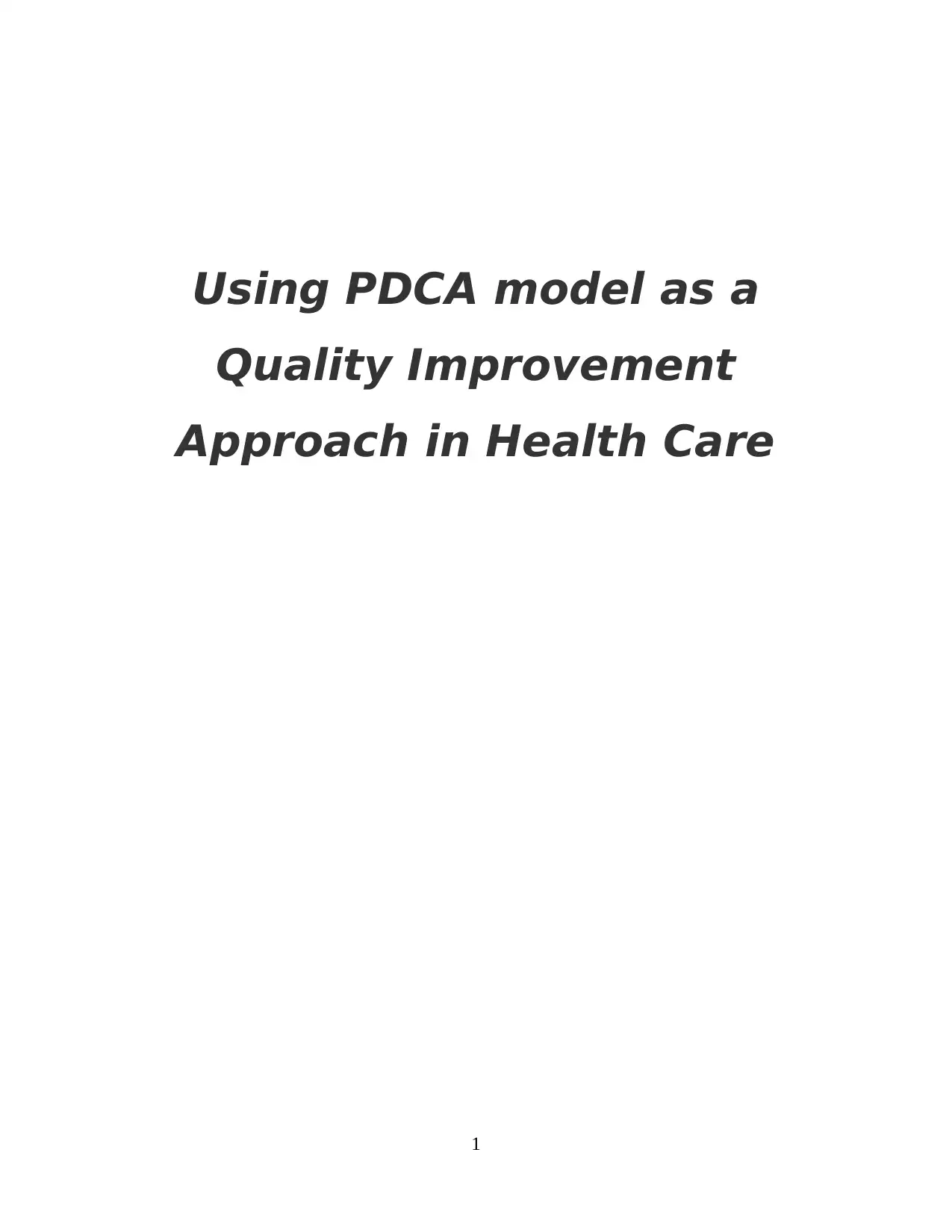
Using PDCA model as a
Quality Improvement
Approach in Health Care
1
Quality Improvement
Approach in Health Care
1
Paraphrase This Document
Need a fresh take? Get an instant paraphrase of this document with our AI Paraphraser
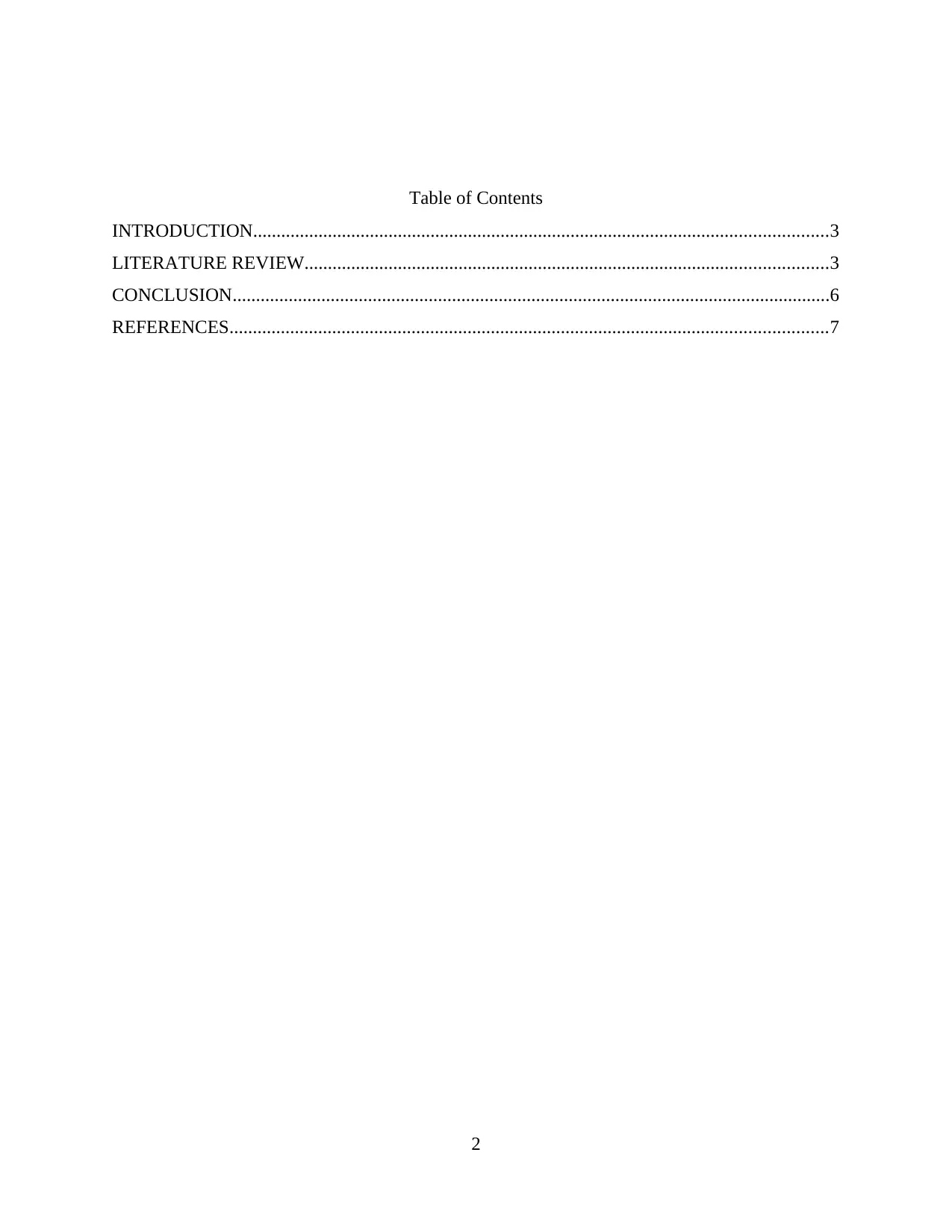
Table of Contents
INTRODUCTION...........................................................................................................................3
LITERATURE REVIEW................................................................................................................3
CONCLUSION................................................................................................................................6
REFERENCES................................................................................................................................7
2
INTRODUCTION...........................................................................................................................3
LITERATURE REVIEW................................................................................................................3
CONCLUSION................................................................................................................................6
REFERENCES................................................................................................................................7
2
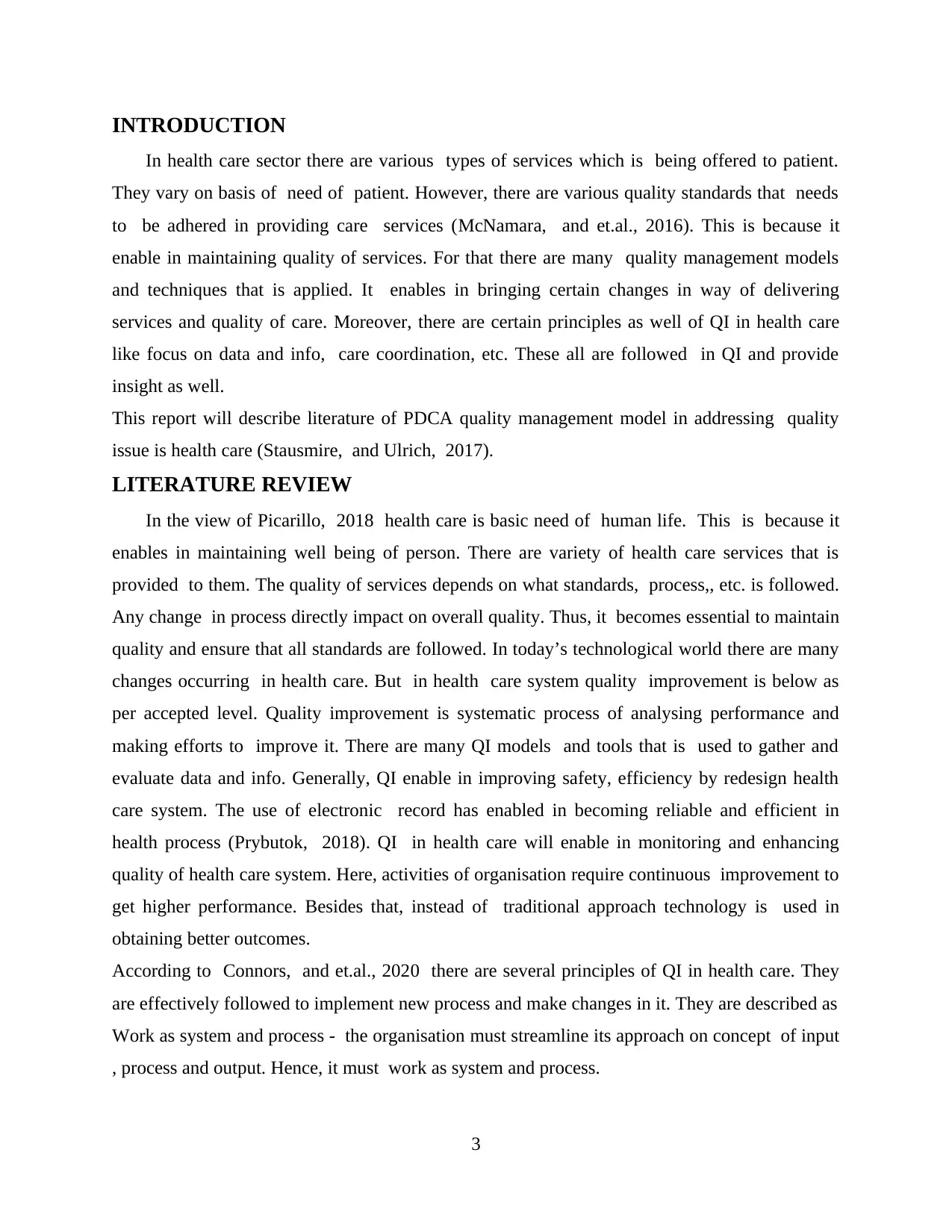
INTRODUCTION
In health care sector there are various types of services which is being offered to patient.
They vary on basis of need of patient. However, there are various quality standards that needs
to be adhered in providing care services (McNamara, and et.al., 2016). This is because it
enable in maintaining quality of services. For that there are many quality management models
and techniques that is applied. It enables in bringing certain changes in way of delivering
services and quality of care. Moreover, there are certain principles as well of QI in health care
like focus on data and info, care coordination, etc. These all are followed in QI and provide
insight as well.
This report will describe literature of PDCA quality management model in addressing quality
issue is health care (Stausmire, and Ulrich, 2017).
LITERATURE REVIEW
In the view of Picarillo, 2018 health care is basic need of human life. This is because it
enables in maintaining well being of person. There are variety of health care services that is
provided to them. The quality of services depends on what standards, process,, etc. is followed.
Any change in process directly impact on overall quality. Thus, it becomes essential to maintain
quality and ensure that all standards are followed. In today’s technological world there are many
changes occurring in health care. But in health care system quality improvement is below as
per accepted level. Quality improvement is systematic process of analysing performance and
making efforts to improve it. There are many QI models and tools that is used to gather and
evaluate data and info. Generally, QI enable in improving safety, efficiency by redesign health
care system. The use of electronic record has enabled in becoming reliable and efficient in
health process (Prybutok, 2018). QI in health care will enable in monitoring and enhancing
quality of health care system. Here, activities of organisation require continuous improvement to
get higher performance. Besides that, instead of traditional approach technology is used in
obtaining better outcomes.
According to Connors, and et.al., 2020 there are several principles of QI in health care. They
are effectively followed to implement new process and make changes in it. They are described as
Work as system and process - the organisation must streamline its approach on concept of input
, process and output. Hence, it must work as system and process.
3
In health care sector there are various types of services which is being offered to patient.
They vary on basis of need of patient. However, there are various quality standards that needs
to be adhered in providing care services (McNamara, and et.al., 2016). This is because it
enable in maintaining quality of services. For that there are many quality management models
and techniques that is applied. It enables in bringing certain changes in way of delivering
services and quality of care. Moreover, there are certain principles as well of QI in health care
like focus on data and info, care coordination, etc. These all are followed in QI and provide
insight as well.
This report will describe literature of PDCA quality management model in addressing quality
issue is health care (Stausmire, and Ulrich, 2017).
LITERATURE REVIEW
In the view of Picarillo, 2018 health care is basic need of human life. This is because it
enables in maintaining well being of person. There are variety of health care services that is
provided to them. The quality of services depends on what standards, process,, etc. is followed.
Any change in process directly impact on overall quality. Thus, it becomes essential to maintain
quality and ensure that all standards are followed. In today’s technological world there are many
changes occurring in health care. But in health care system quality improvement is below as
per accepted level. Quality improvement is systematic process of analysing performance and
making efforts to improve it. There are many QI models and tools that is used to gather and
evaluate data and info. Generally, QI enable in improving safety, efficiency by redesign health
care system. The use of electronic record has enabled in becoming reliable and efficient in
health process (Prybutok, 2018). QI in health care will enable in monitoring and enhancing
quality of health care system. Here, activities of organisation require continuous improvement to
get higher performance. Besides that, instead of traditional approach technology is used in
obtaining better outcomes.
According to Connors, and et.al., 2020 there are several principles of QI in health care. They
are effectively followed to implement new process and make changes in it. They are described as
Work as system and process - the organisation must streamline its approach on concept of input
, process and output. Hence, it must work as system and process.
3
⊘ This is a preview!⊘
Do you want full access?
Subscribe today to unlock all pages.

Trusted by 1+ million students worldwide
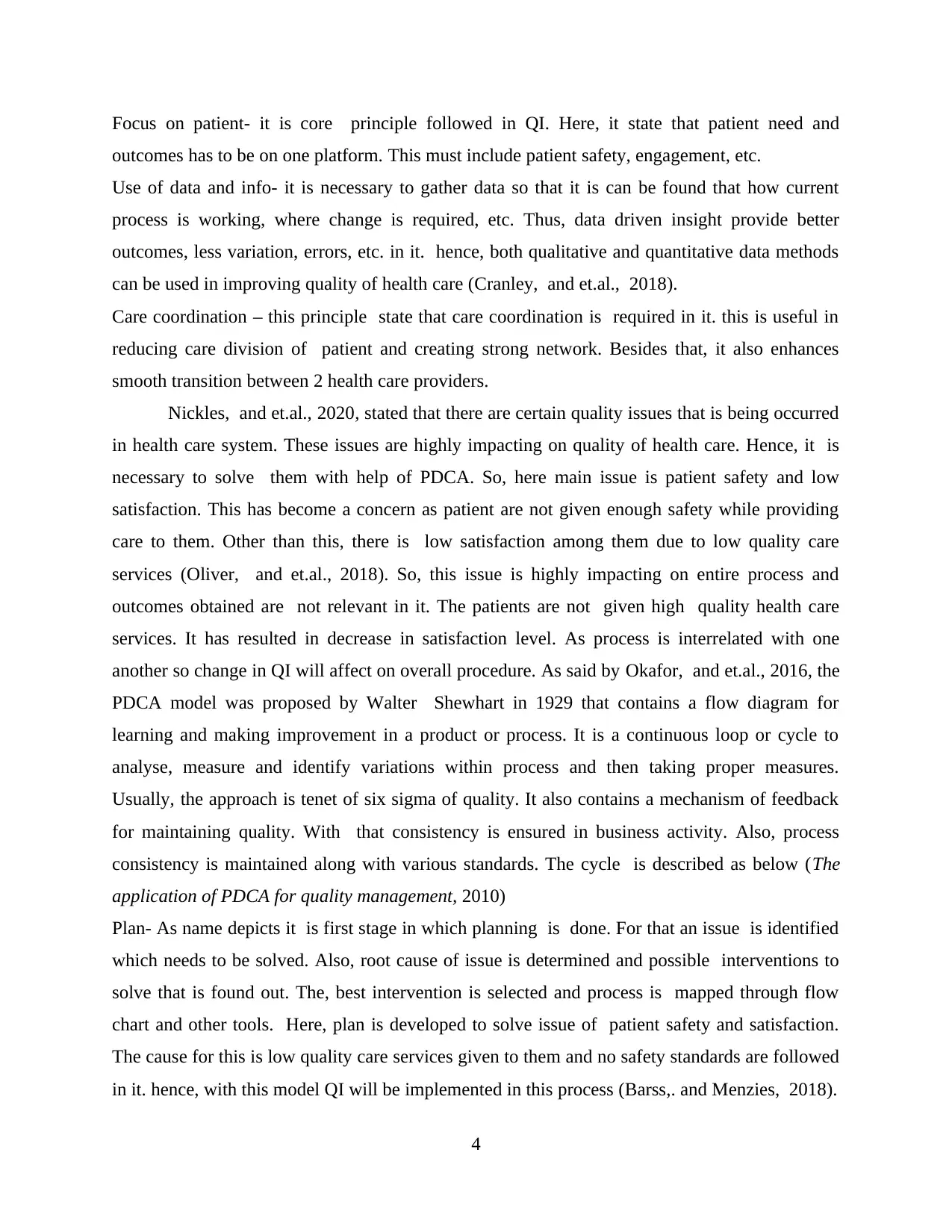
Focus on patient- it is core principle followed in QI. Here, it state that patient need and
outcomes has to be on one platform. This must include patient safety, engagement, etc.
Use of data and info- it is necessary to gather data so that it is can be found that how current
process is working, where change is required, etc. Thus, data driven insight provide better
outcomes, less variation, errors, etc. in it. hence, both qualitative and quantitative data methods
can be used in improving quality of health care (Cranley, and et.al., 2018).
Care coordination – this principle state that care coordination is required in it. this is useful in
reducing care division of patient and creating strong network. Besides that, it also enhances
smooth transition between 2 health care providers.
Nickles, and et.al., 2020, stated that there are certain quality issues that is being occurred
in health care system. These issues are highly impacting on quality of health care. Hence, it is
necessary to solve them with help of PDCA. So, here main issue is patient safety and low
satisfaction. This has become a concern as patient are not given enough safety while providing
care to them. Other than this, there is low satisfaction among them due to low quality care
services (Oliver, and et.al., 2018). So, this issue is highly impacting on entire process and
outcomes obtained are not relevant in it. The patients are not given high quality health care
services. It has resulted in decrease in satisfaction level. As process is interrelated with one
another so change in QI will affect on overall procedure. As said by Okafor, and et.al., 2016, the
PDCA model was proposed by Walter Shewhart in 1929 that contains a flow diagram for
learning and making improvement in a product or process. It is a continuous loop or cycle to
analyse, measure and identify variations within process and then taking proper measures.
Usually, the approach is tenet of six sigma of quality. It also contains a mechanism of feedback
for maintaining quality. With that consistency is ensured in business activity. Also, process
consistency is maintained along with various standards. The cycle is described as below (The
application of PDCA for quality management, 2010)
Plan- As name depicts it is first stage in which planning is done. For that an issue is identified
which needs to be solved. Also, root cause of issue is determined and possible interventions to
solve that is found out. The, best intervention is selected and process is mapped through flow
chart and other tools. Here, plan is developed to solve issue of patient safety and satisfaction.
The cause for this is low quality care services given to them and no safety standards are followed
in it. hence, with this model QI will be implemented in this process (Barss,. and Menzies, 2018).
4
outcomes has to be on one platform. This must include patient safety, engagement, etc.
Use of data and info- it is necessary to gather data so that it is can be found that how current
process is working, where change is required, etc. Thus, data driven insight provide better
outcomes, less variation, errors, etc. in it. hence, both qualitative and quantitative data methods
can be used in improving quality of health care (Cranley, and et.al., 2018).
Care coordination – this principle state that care coordination is required in it. this is useful in
reducing care division of patient and creating strong network. Besides that, it also enhances
smooth transition between 2 health care providers.
Nickles, and et.al., 2020, stated that there are certain quality issues that is being occurred
in health care system. These issues are highly impacting on quality of health care. Hence, it is
necessary to solve them with help of PDCA. So, here main issue is patient safety and low
satisfaction. This has become a concern as patient are not given enough safety while providing
care to them. Other than this, there is low satisfaction among them due to low quality care
services (Oliver, and et.al., 2018). So, this issue is highly impacting on entire process and
outcomes obtained are not relevant in it. The patients are not given high quality health care
services. It has resulted in decrease in satisfaction level. As process is interrelated with one
another so change in QI will affect on overall procedure. As said by Okafor, and et.al., 2016, the
PDCA model was proposed by Walter Shewhart in 1929 that contains a flow diagram for
learning and making improvement in a product or process. It is a continuous loop or cycle to
analyse, measure and identify variations within process and then taking proper measures.
Usually, the approach is tenet of six sigma of quality. It also contains a mechanism of feedback
for maintaining quality. With that consistency is ensured in business activity. Also, process
consistency is maintained along with various standards. The cycle is described as below (The
application of PDCA for quality management, 2010)
Plan- As name depicts it is first stage in which planning is done. For that an issue is identified
which needs to be solved. Also, root cause of issue is determined and possible interventions to
solve that is found out. The, best intervention is selected and process is mapped through flow
chart and other tools. Here, plan is developed to solve issue of patient safety and satisfaction.
The cause for this is low quality care services given to them and no safety standards are followed
in it. hence, with this model QI will be implemented in this process (Barss,. and Menzies, 2018).
4
Paraphrase This Document
Need a fresh take? Get an instant paraphrase of this document with our AI Paraphraser
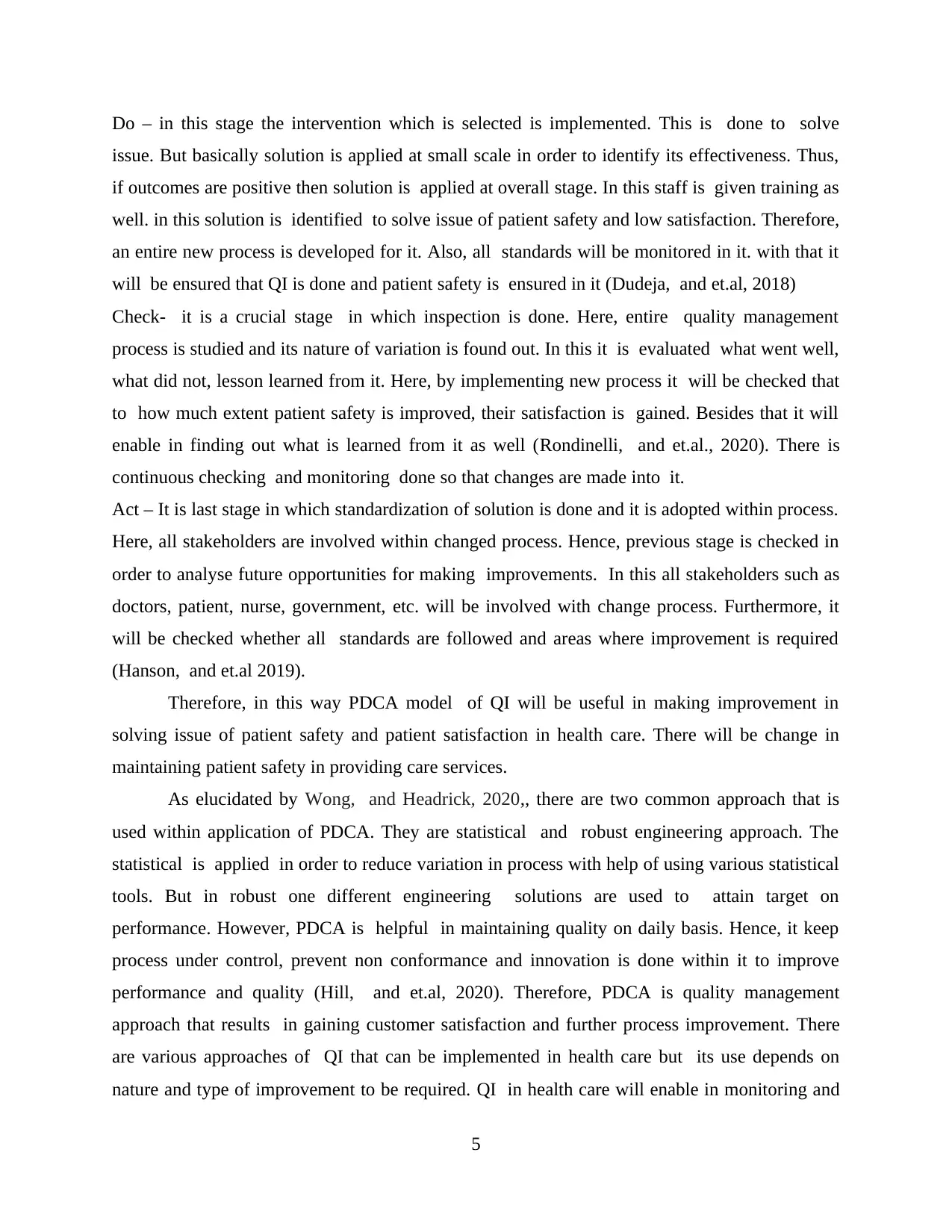
Do – in this stage the intervention which is selected is implemented. This is done to solve
issue. But basically solution is applied at small scale in order to identify its effectiveness. Thus,
if outcomes are positive then solution is applied at overall stage. In this staff is given training as
well. in this solution is identified to solve issue of patient safety and low satisfaction. Therefore,
an entire new process is developed for it. Also, all standards will be monitored in it. with that it
will be ensured that QI is done and patient safety is ensured in it (Dudeja, and et.al, 2018)
Check- it is a crucial stage in which inspection is done. Here, entire quality management
process is studied and its nature of variation is found out. In this it is evaluated what went well,
what did not, lesson learned from it. Here, by implementing new process it will be checked that
to how much extent patient safety is improved, their satisfaction is gained. Besides that it will
enable in finding out what is learned from it as well (Rondinelli, and et.al., 2020). There is
continuous checking and monitoring done so that changes are made into it.
Act – It is last stage in which standardization of solution is done and it is adopted within process.
Here, all stakeholders are involved within changed process. Hence, previous stage is checked in
order to analyse future opportunities for making improvements. In this all stakeholders such as
doctors, patient, nurse, government, etc. will be involved with change process. Furthermore, it
will be checked whether all standards are followed and areas where improvement is required
(Hanson, and et.al 2019).
Therefore, in this way PDCA model of QI will be useful in making improvement in
solving issue of patient safety and patient satisfaction in health care. There will be change in
maintaining patient safety in providing care services.
As elucidated by Wong, and Headrick, 2020,, there are two common approach that is
used within application of PDCA. They are statistical and robust engineering approach. The
statistical is applied in order to reduce variation in process with help of using various statistical
tools. But in robust one different engineering solutions are used to attain target on
performance. However, PDCA is helpful in maintaining quality on daily basis. Hence, it keep
process under control, prevent non conformance and innovation is done within it to improve
performance and quality (Hill, and et.al, 2020). Therefore, PDCA is quality management
approach that results in gaining customer satisfaction and further process improvement. There
are various approaches of QI that can be implemented in health care but its use depends on
nature and type of improvement to be required. QI in health care will enable in monitoring and
5
issue. But basically solution is applied at small scale in order to identify its effectiveness. Thus,
if outcomes are positive then solution is applied at overall stage. In this staff is given training as
well. in this solution is identified to solve issue of patient safety and low satisfaction. Therefore,
an entire new process is developed for it. Also, all standards will be monitored in it. with that it
will be ensured that QI is done and patient safety is ensured in it (Dudeja, and et.al, 2018)
Check- it is a crucial stage in which inspection is done. Here, entire quality management
process is studied and its nature of variation is found out. In this it is evaluated what went well,
what did not, lesson learned from it. Here, by implementing new process it will be checked that
to how much extent patient safety is improved, their satisfaction is gained. Besides that it will
enable in finding out what is learned from it as well (Rondinelli, and et.al., 2020). There is
continuous checking and monitoring done so that changes are made into it.
Act – It is last stage in which standardization of solution is done and it is adopted within process.
Here, all stakeholders are involved within changed process. Hence, previous stage is checked in
order to analyse future opportunities for making improvements. In this all stakeholders such as
doctors, patient, nurse, government, etc. will be involved with change process. Furthermore, it
will be checked whether all standards are followed and areas where improvement is required
(Hanson, and et.al 2019).
Therefore, in this way PDCA model of QI will be useful in making improvement in
solving issue of patient safety and patient satisfaction in health care. There will be change in
maintaining patient safety in providing care services.
As elucidated by Wong, and Headrick, 2020,, there are two common approach that is
used within application of PDCA. They are statistical and robust engineering approach. The
statistical is applied in order to reduce variation in process with help of using various statistical
tools. But in robust one different engineering solutions are used to attain target on
performance. However, PDCA is helpful in maintaining quality on daily basis. Hence, it keep
process under control, prevent non conformance and innovation is done within it to improve
performance and quality (Hill, and et.al, 2020). Therefore, PDCA is quality management
approach that results in gaining customer satisfaction and further process improvement. There
are various approaches of QI that can be implemented in health care but its use depends on
nature and type of improvement to be required. QI in health care will enable in monitoring and
5
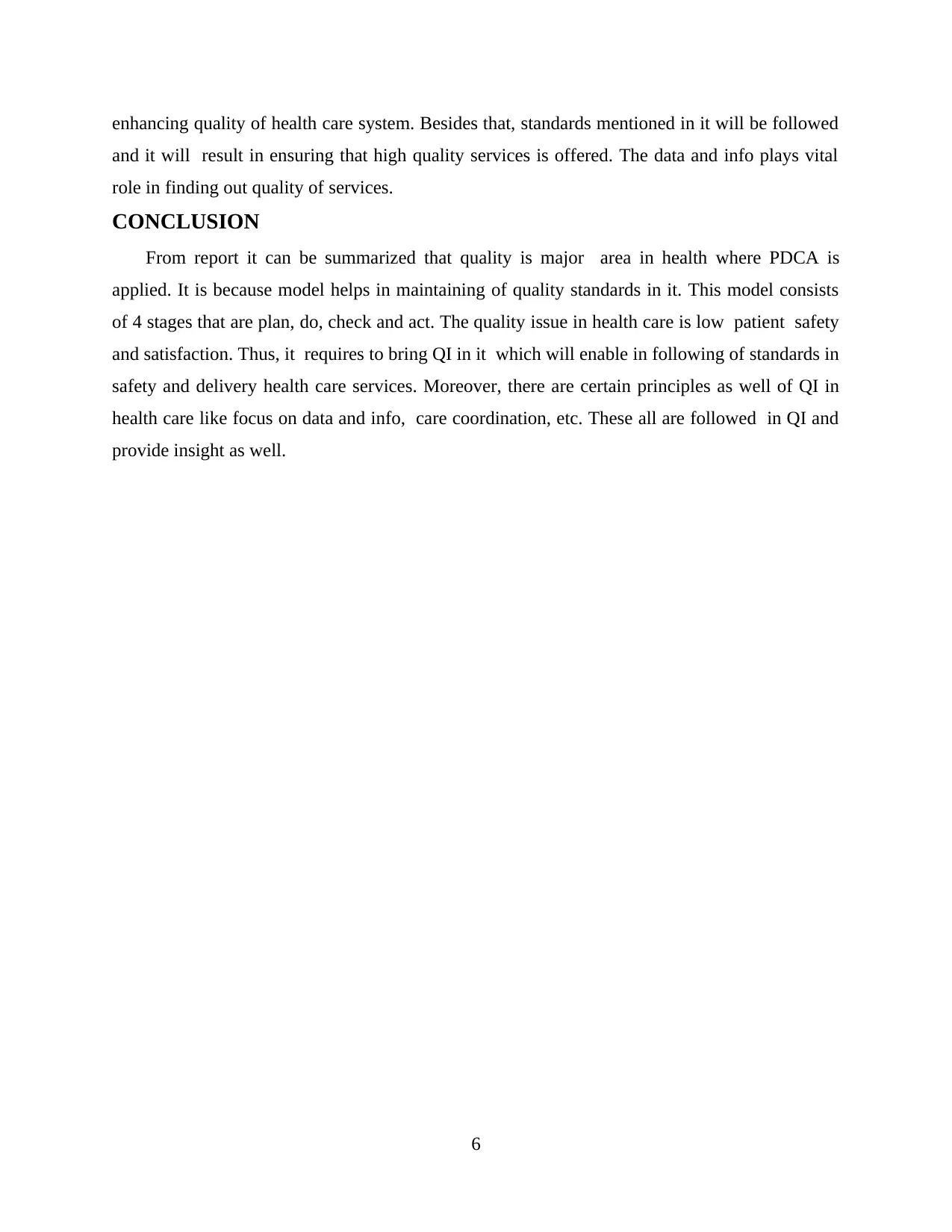
enhancing quality of health care system. Besides that, standards mentioned in it will be followed
and it will result in ensuring that high quality services is offered. The data and info plays vital
role in finding out quality of services.
CONCLUSION
From report it can be summarized that quality is major area in health where PDCA is
applied. It is because model helps in maintaining of quality standards in it. This model consists
of 4 stages that are plan, do, check and act. The quality issue in health care is low patient safety
and satisfaction. Thus, it requires to bring QI in it which will enable in following of standards in
safety and delivery health care services. Moreover, there are certain principles as well of QI in
health care like focus on data and info, care coordination, etc. These all are followed in QI and
provide insight as well.
6
and it will result in ensuring that high quality services is offered. The data and info plays vital
role in finding out quality of services.
CONCLUSION
From report it can be summarized that quality is major area in health where PDCA is
applied. It is because model helps in maintaining of quality standards in it. This model consists
of 4 stages that are plan, do, check and act. The quality issue in health care is low patient safety
and satisfaction. Thus, it requires to bring QI in it which will enable in following of standards in
safety and delivery health care services. Moreover, there are certain principles as well of QI in
health care like focus on data and info, care coordination, etc. These all are followed in QI and
provide insight as well.
6
⊘ This is a preview!⊘
Do you want full access?
Subscribe today to unlock all pages.

Trusted by 1+ million students worldwide
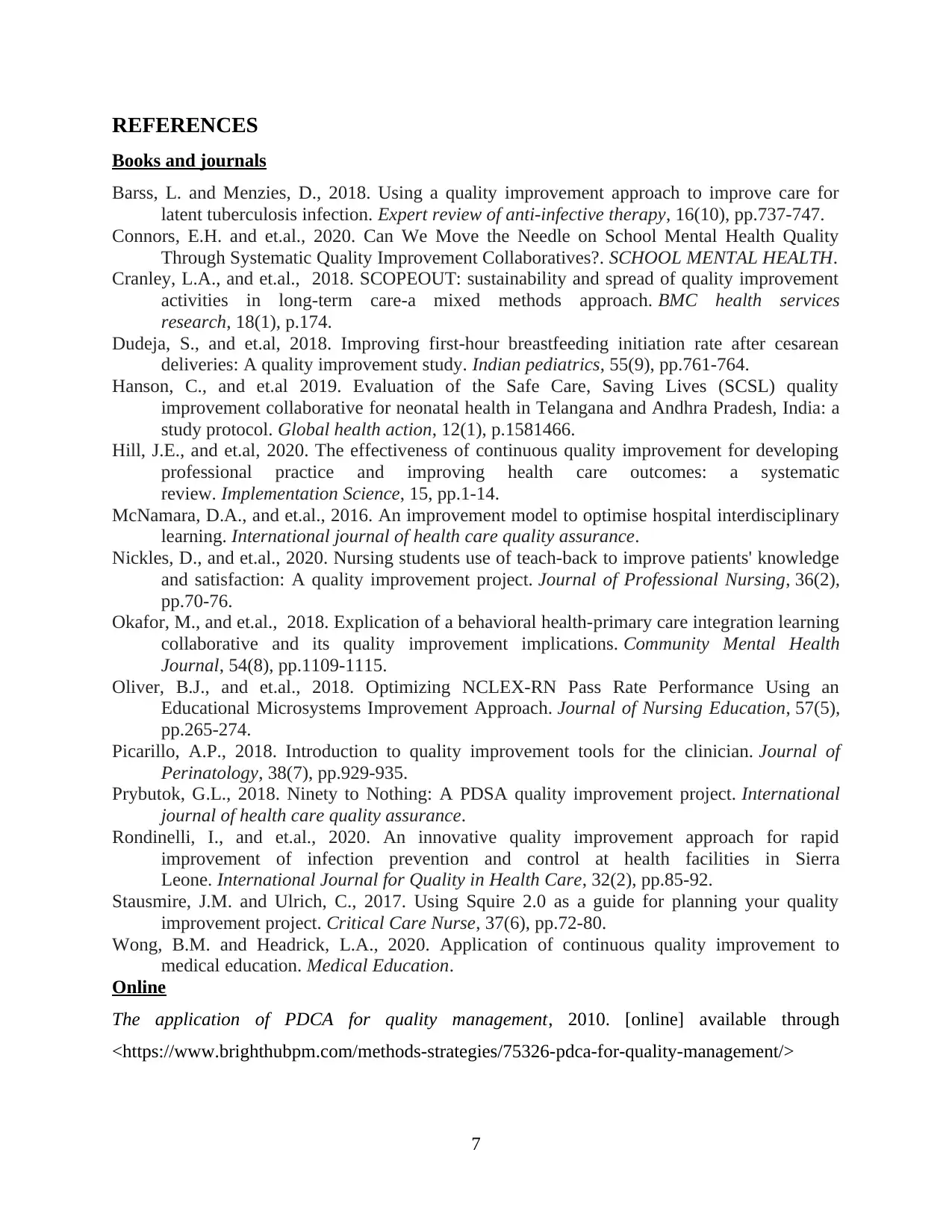
REFERENCES
Books and journals
Barss, L. and Menzies, D., 2018. Using a quality improvement approach to improve care for
latent tuberculosis infection. Expert review of anti-infective therapy, 16(10), pp.737-747.
Connors, E.H. and et.al., 2020. Can We Move the Needle on School Mental Health Quality
Through Systematic Quality Improvement Collaboratives?. SCHOOL MENTAL HEALTH.
Cranley, L.A., and et.al., 2018. SCOPEOUT: sustainability and spread of quality improvement
activities in long-term care-a mixed methods approach. BMC health services
research, 18(1), p.174.
Dudeja, S., and et.al, 2018. Improving first-hour breastfeeding initiation rate after cesarean
deliveries: A quality improvement study. Indian pediatrics, 55(9), pp.761-764.
Hanson, C., and et.al 2019. Evaluation of the Safe Care, Saving Lives (SCSL) quality
improvement collaborative for neonatal health in Telangana and Andhra Pradesh, India: a
study protocol. Global health action, 12(1), p.1581466.
Hill, J.E., and et.al, 2020. The effectiveness of continuous quality improvement for developing
professional practice and improving health care outcomes: a systematic
review. Implementation Science, 15, pp.1-14.
McNamara, D.A., and et.al., 2016. An improvement model to optimise hospital interdisciplinary
learning. International journal of health care quality assurance.
Nickles, D., and et.al., 2020. Nursing students use of teach-back to improve patients' knowledge
and satisfaction: A quality improvement project. Journal of Professional Nursing, 36(2),
pp.70-76.
Okafor, M., and et.al., 2018. Explication of a behavioral health-primary care integration learning
collaborative and its quality improvement implications. Community Mental Health
Journal, 54(8), pp.1109-1115.
Oliver, B.J., and et.al., 2018. Optimizing NCLEX-RN Pass Rate Performance Using an
Educational Microsystems Improvement Approach. Journal of Nursing Education, 57(5),
pp.265-274.
Picarillo, A.P., 2018. Introduction to quality improvement tools for the clinician. Journal of
Perinatology, 38(7), pp.929-935.
Prybutok, G.L., 2018. Ninety to Nothing: A PDSA quality improvement project. International
journal of health care quality assurance.
Rondinelli, I., and et.al., 2020. An innovative quality improvement approach for rapid
improvement of infection prevention and control at health facilities in Sierra
Leone. International Journal for Quality in Health Care, 32(2), pp.85-92.
Stausmire, J.M. and Ulrich, C., 2017. Using Squire 2.0 as a guide for planning your quality
improvement project. Critical Care Nurse, 37(6), pp.72-80.
Wong, B.M. and Headrick, L.A., 2020. Application of continuous quality improvement to
medical education. Medical Education.
Online
The application of PDCA for quality management, 2010. [online] available through
<https://www.brighthubpm.com/methods-strategies/75326-pdca-for-quality-management/>
7
Books and journals
Barss, L. and Menzies, D., 2018. Using a quality improvement approach to improve care for
latent tuberculosis infection. Expert review of anti-infective therapy, 16(10), pp.737-747.
Connors, E.H. and et.al., 2020. Can We Move the Needle on School Mental Health Quality
Through Systematic Quality Improvement Collaboratives?. SCHOOL MENTAL HEALTH.
Cranley, L.A., and et.al., 2018. SCOPEOUT: sustainability and spread of quality improvement
activities in long-term care-a mixed methods approach. BMC health services
research, 18(1), p.174.
Dudeja, S., and et.al, 2018. Improving first-hour breastfeeding initiation rate after cesarean
deliveries: A quality improvement study. Indian pediatrics, 55(9), pp.761-764.
Hanson, C., and et.al 2019. Evaluation of the Safe Care, Saving Lives (SCSL) quality
improvement collaborative for neonatal health in Telangana and Andhra Pradesh, India: a
study protocol. Global health action, 12(1), p.1581466.
Hill, J.E., and et.al, 2020. The effectiveness of continuous quality improvement for developing
professional practice and improving health care outcomes: a systematic
review. Implementation Science, 15, pp.1-14.
McNamara, D.A., and et.al., 2016. An improvement model to optimise hospital interdisciplinary
learning. International journal of health care quality assurance.
Nickles, D., and et.al., 2020. Nursing students use of teach-back to improve patients' knowledge
and satisfaction: A quality improvement project. Journal of Professional Nursing, 36(2),
pp.70-76.
Okafor, M., and et.al., 2018. Explication of a behavioral health-primary care integration learning
collaborative and its quality improvement implications. Community Mental Health
Journal, 54(8), pp.1109-1115.
Oliver, B.J., and et.al., 2018. Optimizing NCLEX-RN Pass Rate Performance Using an
Educational Microsystems Improvement Approach. Journal of Nursing Education, 57(5),
pp.265-274.
Picarillo, A.P., 2018. Introduction to quality improvement tools for the clinician. Journal of
Perinatology, 38(7), pp.929-935.
Prybutok, G.L., 2018. Ninety to Nothing: A PDSA quality improvement project. International
journal of health care quality assurance.
Rondinelli, I., and et.al., 2020. An innovative quality improvement approach for rapid
improvement of infection prevention and control at health facilities in Sierra
Leone. International Journal for Quality in Health Care, 32(2), pp.85-92.
Stausmire, J.M. and Ulrich, C., 2017. Using Squire 2.0 as a guide for planning your quality
improvement project. Critical Care Nurse, 37(6), pp.72-80.
Wong, B.M. and Headrick, L.A., 2020. Application of continuous quality improvement to
medical education. Medical Education.
Online
The application of PDCA for quality management, 2010. [online] available through
<https://www.brighthubpm.com/methods-strategies/75326-pdca-for-quality-management/>
7
Paraphrase This Document
Need a fresh take? Get an instant paraphrase of this document with our AI Paraphraser

8
1 out of 8
Related Documents
Your All-in-One AI-Powered Toolkit for Academic Success.
+13062052269
info@desklib.com
Available 24*7 on WhatsApp / Email
![[object Object]](/_next/static/media/star-bottom.7253800d.svg)
Unlock your academic potential
Copyright © 2020–2025 A2Z Services. All Rights Reserved. Developed and managed by ZUCOL.





